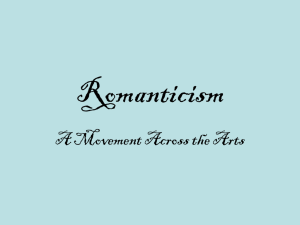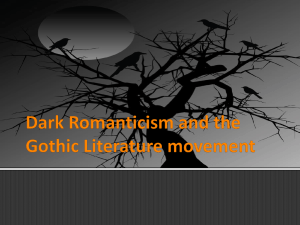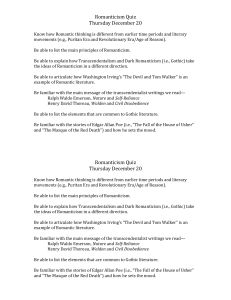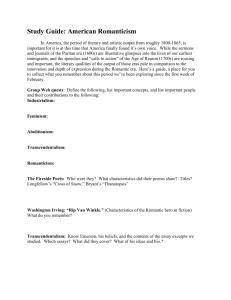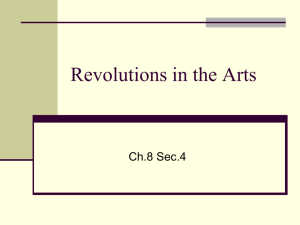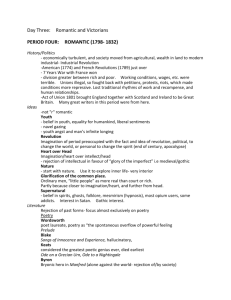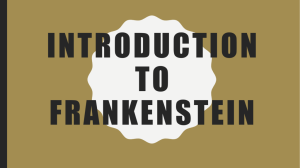Romanticism - Brookwood High School
advertisement
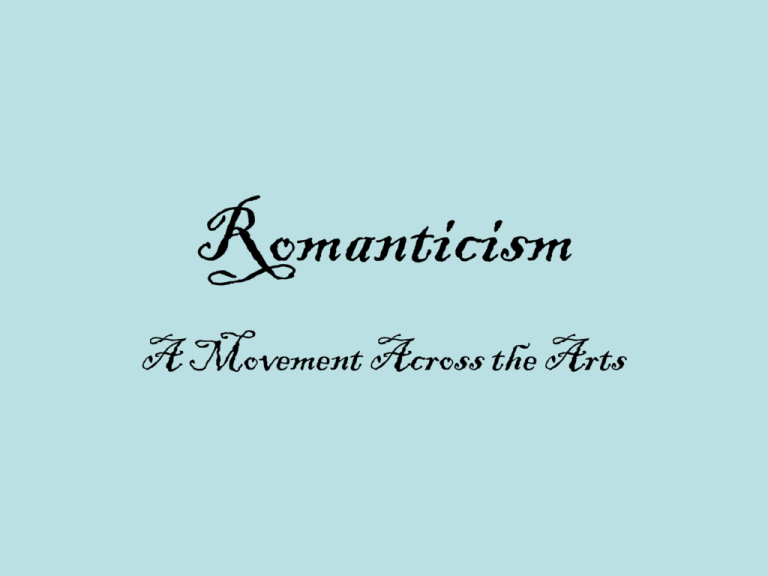
Romanticism A Movement Across the Arts Definition Romanticism refers to a movement in art, literature, and music during the 19th century. Romanticism is characterized by the 5 “I”s Imagination Intuition Idealism Inspiration Individuality Imagination Imagination was emphasized over “reason.” This was a backlash against the rationalism characterized by the Neoclassical period or “Age of Reason.” Imagination was considered necessary for creating all art. British writer Samuel Taylor Coleridge called it “intellectual intuition.” Intuition Romantics placed value on “intuition,” or feeling and instincts, over reason. Emotions were important in Romantic art. British Romantic William Wordsworth described poetry as “the spontaneous overflow of powerful feelings.” Idealism Idealism is the concept that we can make the world a better place. Idealism refers to any theory that emphasizes the spirit, the mind, or language over matter – thought has a crucial role in making the world the way it is. Immanuel Kant, a German philosopher, held that the mind forces the world we perceive to take the shape of space-andtime. Inspiration The Romantic artist, musician, or writer, is an “inspired creator” rather than a “technical master.” What this means is “going with the moment” or being spontaneous, rather than “getting it precise.” Individuality Romantics celebrated the individual. During this time period, Women’s Rights and Abolitionism were taking root as major movements. Walt Whitman, a later Romantic writer, would write a poem entitled “Song of Myself”: it begins, “I celebrate myself…” Origins Romanticism began to take root as a movement following the French Revolution. The publication of Lyrical Ballads by William Wordsworth and Samuel Taylor Coleridge in 1792 is considered the beginning of literary Romanticism. The Arts Romanticism was a movement across all the arts: visual art, music, and literature. All of the arts embraced themes prevalent in the Middle Ages: chivalry, courtly love. Literature and art from this time depicted these themes. Music (ballets and operas) illustrated these themes. Shakespeare came back into vogue. Visual Arts Neoclassical art was rigid, severe, and unemotional; it hearkened back to ancient Greece and Rome Romantic art was emotional, deeplyfelt, individualistic, and exotic. It has been described as a reaction to Neoclassicism, or “anti-Classicism.” Visual Arts: Examples Romantic Art Neoclassical Art Music “Classical” musicians included composers like Wolfgang Amadeus Mozart and Franz Josef Haydn. Romantic musicians included composers like Frederic Chopin, Franz Lizst, Pyotr Il’yich Tchaikovsky Music: Components 1730-1820. Classical music emphasized internal order and balance. 1800-1910. Romantic music emphasized expression of feelings. Literature In America, Romanticism most strongly impacted literature. Writers explored supernatural and gothic themes. Writers wrote about nature – Transcendentalists believed God was in nature, unlike “Age of Reason” writers like Franklin and Jefferson, who saw God as a “divine watchmaker,” who created the universe and left it to run itself. Nathaniel Hawthorne •Born on the 4th of July in Salem, MA •Descendent of a prominent Puritan family who traveled here from Europe to settle the new colony with John Winthrop •His great-grandfather was Judge Hathorne of the Salem witch trials. •He felt so guilty about his ancestors’ persecution of others that this shaped both his character and his writing. •He changed the family name from “Hathorne” to “Hawthorne” in order to remove himself from the shame he felt about his Puritan ancestors •He believed that evil was the dominant force in the world, and his fiction expresses a gloomy vision of human affairs. •He chooses to examine the DARK side of human nature (Dark Rom) The Gothic Romance • Combines elements of Romanticism with those of the Gothic Novel. • type of romantic fiction that predominated in English literature in the last third of the 18th century and the first two decades of the 19th century. • The Gothic novel, or Gothic romance, emphasized mystery and horror and was filled with ghost-haunted rooms, underground passages, and secret stairways. Elements of the Gothic Novel • • • • • • • • • Setting in a castle Atmosphere of mystery and suspense Ancient prophecy Omens, visions Supernatural or inexplicable events High, overwrought emotion Women in distress Women threatened by powerful, tyrannical male. Mood of gloom and horror The Scarlet Letter as a Gothic Romance • The novel will have some, but not all, of the characteristics of Romanticism and the Gothic Novel. • The following elements are shown throughout the novel: Idealism, Individuality, Intuition, atmosphere of mystery and suspense, supernatural or inexplicable events, gloom and horror, women threatened by powerful, tyrannical male, women in distress, and overwrought emotion. Outcasts in Society • How do outcasts change society’s norms? • How and why do cultural norms change? • How do the norms of our generation affect our view of the norms of past civilizations? • Does society need outcasts? • What is an individual’s responsibility to society? • What is society’s responsibility to outcasts? • Who are some modern or historical outcasts? The Scarlet Letter: The Custom House 1850 •Hawthorne worked at the Custom House for two years. •The Custom House is a preface to the novel that gives us author’s information, explains the history behind the novel, and tells about how Hawthorne got the idea for this romance novel •Puritans founded a religious colony, but the religious ideals were devoured by financial greed and commercialism of the 1700s. •Hawthorne explains that, although he has a deep connection with both his ancestors and Salem, he disapproves of the stern rigidity of their Puritan ways. •He gives his definition of the romance novel and tells of the importance that light plays. •In certain light, objects “seem to lose their actual substance, and become things of intellect.” •There really is no historical evidence that the finding of this letter is true. •This was a technique common in his day that gave stories some validity to the readers.
